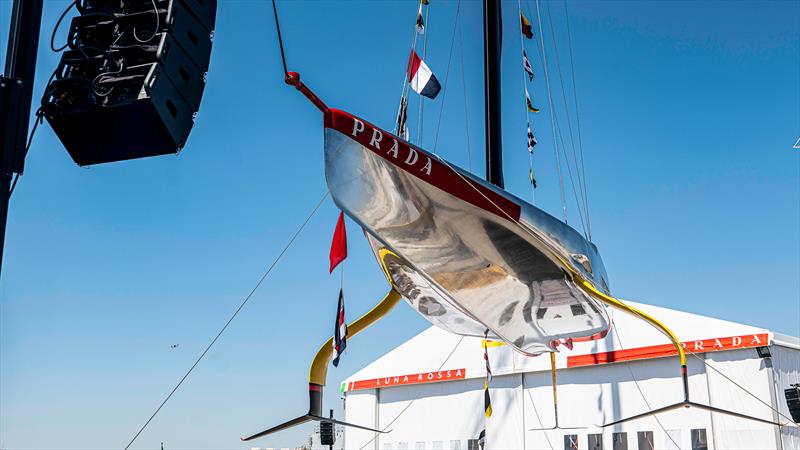
Luna Rossa Prada Pirelli - AC75 - Cagliari, Sardinia - April 13, 2024 - photo © AC37 Joint Recon Team
Dear Recipient Name
Love 'em or hate 'em, the current America's Cup yachts certainly represent the cutting-edge of foiling and are the fastest windward-leeward sailing machines on water.
This past week has seen three launches, each in a very different style. The Swiss Alinghi Red Bull Racing yacht came out of the shed with razzmatazz, the Italian challenger Luna Rossa Prada Pirelli was presented with glamour, while the defender Emirates Team New Zealand rolled out in Auckland to very little fanfare and proceeded to go sailing from the get-go.
While the hulls are just a part of the equation, we're already gaining some insights as to the design philosophy each of the teams are employing. Let's go through them in launch order.
Alinghi Red Bull Racing's hull looks aggressive. It's not just the charging bull on the bow that portrays this image, as the boat is angular, with a chine on the bow, and the stern deck cut away to be 'backless' behind the crew pods.
The deck has a marked concave between the forestay and the crew pods, while sloping down assertively between the forestay and bow. Underneath the bow entry is much finer than the previous generation of AC75s - a common theme of all the launches to date.
The Italians of course brought style to their launch, dramatically lowering a black curtain to reveal their stunning silver hull, emblazoned with Prada on the bow, Luna Rossa to the aft, and Pirelli on the foil arms. The silver is a throwback to their 2013 AC72 which they sailed in San Francisco. Will we see the matching silver helmets and jackets?
The hull lines are clean and appear less combative than the Swiss yacht, with the bustle tapering upwards towards the stern.
Each crew pod is designed to be specific for that crew member's role, resulting in the cyclor pods being longer than the sailors' pods, all to reduce windage as much as possible. It looks like the helmsmen (one each side) will be the furthest forward in the boat with the trimmer situated just behind, which would make sense to be able to look up at the mainsail, while also having an unobscured view of the jib. It may seem back-to-front compared to classic sailing, but these boats aren't in any way traditional.
The deck has a slight concave forward of the mast, sweeping up into the crew pods either side, before tapering away to the stern. The Italian yacht is certainly eye-catching, but would we expect anything less from the luxury fashion house-sponsored team?
There is much talk in sailing about the 'end plate' effect. The favourable aerodynamic characteristics of wing-in-ground (WIG) effect craft have been known for a hundred years, with applications in aircraft and high-speed water vehicles. A wing with a small angle of attack (i.e. pointing close to the wind as an AC75 always is when foiling) increases lift and decreases drag. In AC75s this is achieved by the bustle, and the aim is to fly the hull as close to the water as possible. How this plays out in the considerable swell off Barcelona will be interesting.
As you can see above, Emirates Team New Zealand's crew are arranged with the cyclors aft of the sailing team, as seen in the Luna Rossa deck layout shown earlier.
The under-deck boom seen in the 36th America's Cup has been refined and optimised, with the aim of reducing drag and increasing efficiency. Early sailing photos show this in action on the new Emirates Team New Zealand yacht.
All the boats have an ultra-clean deck layout as reducing windage is paramount. The mechanics and electronics are below deck, and for the jib all we'll see is a single sheet leading into a slit in the deck. With all the new launches, what happens below deck is going to be a well-kept secret.
Foils will be kept under wraps as long as possible. Emirates Team New Zealand are using legacy foils for their sailing in Auckland, while Alinghi Red Bull Racing's foils were kept in boxes for the launch.
It was remarkable to see Emirates Team New Zealand sailing on the first day with their new yacht. This is a team clearly signalling that they are all business in their defence of the Auld Mug.
We are yet to see the hulls of INEOS Britannia, New York Yacht Club American Magic and the French Orient Express Racing Team.
NYYC American Magic's hull has been transported from Providence, Rhode Island, USA to Barcelona, Spain by an Antonov Airlines AN-124-100.
INEOS Britannia has made the 1,000-mile journey from its UK base in Northamptonshire to Barcelona, Spain by truck and ferry from Portsmouth to Bilbao.
We can expect the Orient Express Racing Team AC75 to broadly follow the lines of the Kiwi yacht as they bought that design package to get their first-time campaign up to speed.
The aim now for all the teams is time to work up their yachts and optimise their systems. Allowing the crew to get their hulls, foils, and sails to work in perfect harmony is complex and can't all be done in simulators and on computers.
There are just 129 days until the Barcelona Preliminary Regatta, with then just a few days until the first races of the Louis Vuitton Cup Round Robins. It's going to be all systems go for the teams between now and the racing, and we'll bring you everything on Sail-World.com and YachtsandYachting.com
Mark Jardine
Sail-World.com and YachtsandYachting.com Managing Editor
|